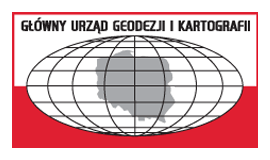-
National Register of Geographical Names
The National Register of Geographical Names (PRNG) is an official reference database that provides the basis for other spatial information systems that use geographic nomenclature data. The PRNG consists of two parts, including: The PRNG covering geographical names from the territory of Poland contains data on official, standardized and non-standardized names of geographical objects and…
-
National Register of Boundaries
The National Register of Boundaries (PRG) is an official reference database that provides the basis for other spatial information systems and uses data concerning administrative units of the country. The PRG covers the area of the whole country and contains information about boundaries and areas of the fundamental three-level administrative division of the country (i.e.…
-
Basic Geodetic Network (PRPOG)
The National Register of Basic Geodetic, Gravimetric and Magnetic Networks (PRPOG) contains information, data (including archived data), collections of observations, and elaborations of observation results concerning points of basic geodetic, gravimetric and magnetic networks for the entire country. PRPOG collects data concerning points of relevant control networks as well as sets of observations made in…
-
Database of General Geographic Objects (BDOO)
The Database of General Geographical Objects (BDOO) is a vector (object) database which contains the spatial location of most important topographic features along with a basic description of their properties. The content and detail level of the BDOO database corresponds to a general geographic map at the scale of 1:250,000, whereas its scope covers information…
-
Photogrammetric aerial imagery
Aerial imagery collected in the central geodetic and cartographic resource (czgik) are images of the terrain surface obtained using specialized cameras installed on board the plane. According to regulation of December 16, 2022 on databases for aerial and satellite imagery, orthophotomap and digital terrain models, photogrammetric aerial imagery are collected in czgik: • vertical, constituting…
-
Orthophotomap (ORTO)
The orthophotomap represents a raster Earth surface image created by processing aerial or satellite images. Pursuant to the Geodetic and cartographic law act, the person responsible for the maintenance of the orthophotomap database in Poland is the Surveyor General of Poland. At the moment, the most accurate orthophotomaps available in the National Geodetic and Cartographic…
-
Digital Elevation Model (DEM)
The Digital Elevation Model (DEM) is a discrete (point-based) representation of land surface elevation. It uses an interpolation algorithm to calculate the elevation at any point of a surface covered by the constructed model. Generally, there are two basic types of DEM based on different geometric structures: GRID – model based on a regular square…
-
Digital Surface Model (DSM)
The Digital Surface Model (DSM) represents terrain surface along with any objects and features protruding over it, such as buildings, trees, bridges, overpasses and other infrastructure. Poland maintains and updates the DSM based on a 0.5×0.5 m mesh for urban areas and on a 1.0×1.0 m mesh for the rest of the territory. At the…
-
Topographic Objects Database (BDOT10k)
The Topographic Objects Database (BDOT10k) is a vector database which contains the spatial location of topographic features along with a basic description of their properties. The content and detail level of the BDOT10k database generally corresponds to a traditional topographic map at the scale of 1:10,000, and Fig. 1 shows a fragment of a sample…
-
Land and building register (EGiB)
The Land and Building Register is maintained by heads of counties, which results in 380 units being responsible for maintaining them. The EGiB data, and in particular the data on cadastral parcels, are the primary reference data for the presentation of various other objects and features collected in spatial information databases. In addition, a parcel…
-
Utilities network (GESUT)
The utilities network databases (GESUT) contain information about the existing and designed utility lines and related infrastructure. They are maintained by the heads of counties which means that there are 380 units responsible for maintaining them. Data on the utility networks is extremely useful in the investment process, for real estate valuation and in other…
-
Topographic Objects Database (BDOT500)
Topographic features collected in BDOT500 databases together with, among others, objects of land and building registration or utilities network make up a large-scale base map. The BDOT500 databases are maintained by heads of counties, which results in 380 units being responsible for maintaining them. In 2019, the Head Office of Geodesy and Cartography (GUGiK) integrated…
-
Detailed Control Network Database (BDSOG)
The Detailed Control Network Database (BDSOG) is maintained by the heads of counties, which means that there are 380 units responsible for the maintenance of this database. BDSOG contains information concerning points of detailed horizontal and vertical geodetic control network for the area of the specific county, including sets of observations made in order to…
-
Maps
Topographic maps A topographic map is a cartographic representation of general-purpose geographic content, especially topographic objects and features, at scales from 1:10,000 to 1:100,000. Standards for the development of topographic maps are specified by the Regulation of the Minister of Development, Labour and Technology of 27 July 2021 on the topographic objects database and the…
-
Other data
-
3D mesh models
3D mesh models are three-dimensional visualizations of objects covered with image textures from oblique aerial imagery. The model is created by applying algorithms for automatically matching common points on all images – both oblique and vertical, using data from laser scanning. 3D mesh models can be downloaded for free using the index maps available on…
-
LIDAR measurements (LIDAR)
Light Detection and Ranging (LIDAR) measurements obtained from airborne laser scanning (ALS) provide a representation of land as a cloud of measurement points with defined XYZ coordinates. The files are saved in LAS format and, apart from point coordinates, they also contain, among other things, information on the class of a specific point, or on…
 Head Office of Geodesy and Cartography (GUGiK)
Head Office of Geodesy and Cartography (GUGiK)
 Geoportal.gov.pl
Geoportal.gov.pl
Geoportal Infrastruktury Informacji Przestrzennej